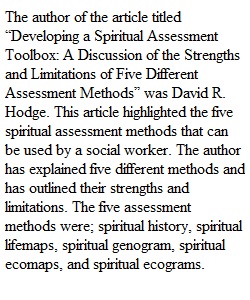


Q JOURNAL ARTICLE REVIEW 1 JOURNAL ARTICLE REVIEW: THE BIBLE AND THE CHRISTIAN COUNSELOR ASSIGNMENT INSTRUCTIONS OVERVIEW You will write 2 Journal Article Reviews, which will be based upon your choice of articles from the professional, peer-reviewed journal articles provided in Canvas under Journal Article Review Resources. No outside articles will be accepted. Each Journal Article Review must be 3–5+ double-spaced pages (not including the title and reference pages) and created in a Microsoft Word document. Use the following guidelines to create your paper. This second journal article review will follow the format and instructions of your first review but you choose a different journal article to review for this assignment. INSTRUCTIONS 1. Start your paper with a title page, correctly formatted per current APA. Use the provided template and the basic current APA components will be in place. Divide your paper into sections with the following Level One headings: Summary, Reflection, and Application as described on the template. 2. Develop a summary of the main concepts from the article. Do not duplicate the article’s abstract. If the article describes a research study, include brief statements about the hypotheses, methods, results, discussion, and implications. If any test measures or statistical methods used are given in the article, do not provide detailed descriptions of these. Short direct quotations from the article are acceptable but avoid long quotes in a paper this size. This section is the foundation of your Journal Article Review (at least a third of your paper). Make sure you include the core points from the article, even if it means a longer section. Do not reference any additional articles in your summary. 3. In approximately 1+ page, reflect on the article using your own words. Appropriate comments for this part of the paper could include, but are not limited to, your initial response to the article, comments regarding the study's design or methodology (if any), insights you gained from reading the article, your reasons for being interested in this particular article, any other readings that you may plan to do based upon having read the article, and other thoughts you have that might further enhance the discussion of your article. Your subjective comments in this section must be clearly tied to main points from the article, not peripheral ideas. Again, do not reference any other article. 4. In your final section, in approximately 1+ page(s), write how you would apply the information you have learned from this article to a particular counseling setting. Make this setting one that would typically be seen in human services counseling—community services agencies, adoption agencies, volunteer counseling settings such as in churches, etc. Develop this section as if you are a pastor or clinician and your parishioner or client has come to you with a problem—grief, depression, substance abuse, relationships problems, etc.— needing your help. Adequately describe the counseling scenario including the presenting problem. Draw out concepts from the article and apply them to the scenario as if you were guided only by the content of the article. Show the reader how you expressly drew from the journal article in this application section and cite correctly, per APA. This assignment incudes an APA template for the current APA version. You simply need to put your information into the various areas (running head, title, etc.) and the template itself instructs you how to add your information and delete the instruction comment balloons. Using the APA template with put you on a track of getting the “basics” of APA correct. Note: Your assignment will be checked for originality via the Turnitin plagiarism tool.
View Related Questions